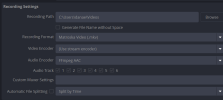Is there really any point in responding to someone if you only plan to ignore exactly what they asked and answered with nothing relevant whatsoever?
It's fairly straight forward what is being asked here, I find it hard to comprehend how you can't fathom it... When you record with separate mixer tracks enabled, where exactly ARE these separate mixer stems? When you record, it either doesn't record them or merges them together. The option for separate audio tracks is precisely useless if there is no method of keeping them separate for POST processing.
I too have this exact issue. It either merges them together (ergo, no separate mixer tracks whatsoever) or only records one of them and the rest are lost forever. What exactly is the point in this feature if it cannot do the most basic thing expected of it based on the functions name? If we can have separate mixer channels, why can we not EXPORT separate mixer channels? Seems completely ridiculous to me.
As for re-syncing the audio later, that's none of your concern and is completely pointless to ask.I shoulnd't have to rely on multiple pieces of software to do one simple task when OBS already has the means right there to do what it already claims it can.
Almost reported you for abuse. I can see you're frustrated, but this is not the place to vent it.
Anyway, a video file is not a monolithic block. If you "open the lid", so to speak, you'd see a set of independent tracks in there that all stay in sync: silent video and blind audio, with potentially multiples of each. Most players only choose one of each at a time, defaulting to #1 for each, but OBS can create up to 6 audio tracks and (at least) 1 video track in the same file.
(a recent addition to OBS might increase the number of video tracks, if I understand it correctly, but I haven't had reason to try it yet)
And like i said before, any editor that's worth using will be able to use all of those separate tracks. So you can indeed use the Track selections in OBS to create up to 6 stems to mix later, and then use the editor to pick those 6 stems out of the same video file.
---
As soon as you have separate files, the inherent sync goes away*, which is a big red flag for OBS's intended purpose. If you're using it outside of that purpose, then it *might* just happen to work well enough anyway, but you don't really have a right to complain either. For the discussion here, OBS is not a DAW and never will be. If you need serious audio functionality, you need to use a real DAW for that, and not OBS.
(DAW = Digital Audio Workstation. Essentially a complete sound studio all in one app. It only does audio, and it does it VERY WELL!)
If you do need some serious audio processing (it really doesn't take much), then you need to split your workflow into [silent video in OBS] and [blind audio in the DAW], connect all of your audio sources directly to the DAW and not OBS, and then pipe the final result from the DAW into OBS. OBS then, has only that one audio source in total, and it passes that through completely unchanged. No audio filters at all in OBS, and fader at 0dB or 100%. Use the DAW to put OBS's meter where you want it and to make it sound like you want.
If you're doing that, and you have some audio that originates in OBS, like a video soundtrack or camera feed, then you (ab)use OBS's Monitor to send that directly to the DAW. Again, no processing at all in OBS; it's all in the DAW. Use OBS's routing options to send the [raw out to the DAW] only to the Monitor, and the [finished in from the DAW] only to the stream / finished recording.
If you want stems or multitrack in that situation, you do that with the DAW. OBS has nothing to do with it.
And, if you're using a DAW, then your headphones/speakers come from there too, not from OBS. That frees up OBS's Monitor to do what I'm saying here.
---
* You can keep a guaranteed sync by using lossless formats, like FLAC or PCM (WAV uses PCM internally), that actually give you back the original stream of samples. But most streams and casual recordings are lossy to save space and bitrate. Lossy formats re-generate stuff on playback, and may not necessarily line up without a working sync mechanism. Within the same file, that mechanism exists. But not necessarily between files.

